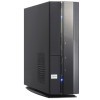- Qualcomm Launches Snapdragon 4 Gen 2 Mobile Platform
- AMD Launches Ryzen PRO 7000 Series Mobile & Desktop Platform
- Intel Launches Sleek Single-Slot Arc Pro A60 Workstation Graphics Card
- NVIDIA Announces Latest Ada Lovelace Additions: GeForce RTX 4060 Ti & RTX 4060
- Maxon Redshift With AMD Radeon GPU Rendering Support Now Available
ASUS P-Series AMD 690G Barebone PC

What if you could build a sub-$500 HTPC that was slim, fast, and capable, without the headache of picking bargain-barrel parts to accomplish your design goals? What if it had HDMI and 7.1 audio? With the help of their Pundit series, ASUS hopes to make barebones relevant again. Have they done it?
Page 8 – System: HD Tach RW3 & Sandra Memory Tests
Simpli Software HD Tach RW 3
To test the storage subsystem, we rely on Simpli Software’s HD Tach, a superb storage benchmarking tool that’s now free for everyone to use. It excels at benchmarking a variety of internal and external storage devices, and produces consistent data and information-rich reports.
For this review, HD Tach will be used to test the internal hard drive’s data transfer rates. Since the main system drive is being tested, which contains the operating system software, we will only be performing read tests, not write tests (which might cause data corruption.) Also, since we’re not specifically interested in the drive’s performance per se, we won’t be running any access time testing.

From these results, it would appear that the SATA controller aboard the SB600 southbridge is capable of approximately equal continuous read transfer rates, though the difference is so small that it’s likely more affected by the hard drive we’re using than the SATA controller. When it comes to burst read rates, however, the AMD SB600’s onboard controller manages a transfer rate that beats the nForce 430-based motherboard by 16 MB/s.
SiSoftware Sandra XII 2008 SP2
SiSoft’s Sandra benchmarking package has long been one of our favorite tools, because of its comprehensive set of specific hardware benchmarks. It delivers excellent consistency, and offers a variety of tests devoted to the memory subsystem. Here, we’ll use it to test memory bandwidth and latency.


Overall, the motherboard based on the GeForce 6150 chipset turned in better numbers consistently through our memory benchmark testing. AMD Socket AM2 and AM2+ IGP motherboards gain access to RAM via the CPU’s onboard memory controller, so the quality of the link between the CPU and memory can also affect the performance of the motherboard chipset’s integrated GPU. Here, the reference nForce 430-based motherboard outpaces the AMD 690G-based barebone by about 4% in either of our bandwidth tests, and claims a solid 17% lead over the 690G-based barebone in memory latency.
Now that we’ve seen how well the ASUS P2-M2A690G handles data, let’s look at the differences in gaming performance you can expect between the two. Of course, we don’t anticipate either our reference GeForce 6150-based motherboard or the P2-M2A690G’s integrated Radeon X1250 GPU to be stellar performers, but we’re more interested in observing differences in performance.
Support our efforts! With ad revenue at an all-time low for written websites, we're relying more than ever on reader support to help us continue putting so much effort into this type of content. You can support us by becoming a Patron, or by using our Amazon shopping affiliate links listed through our articles. Thanks for your support!




